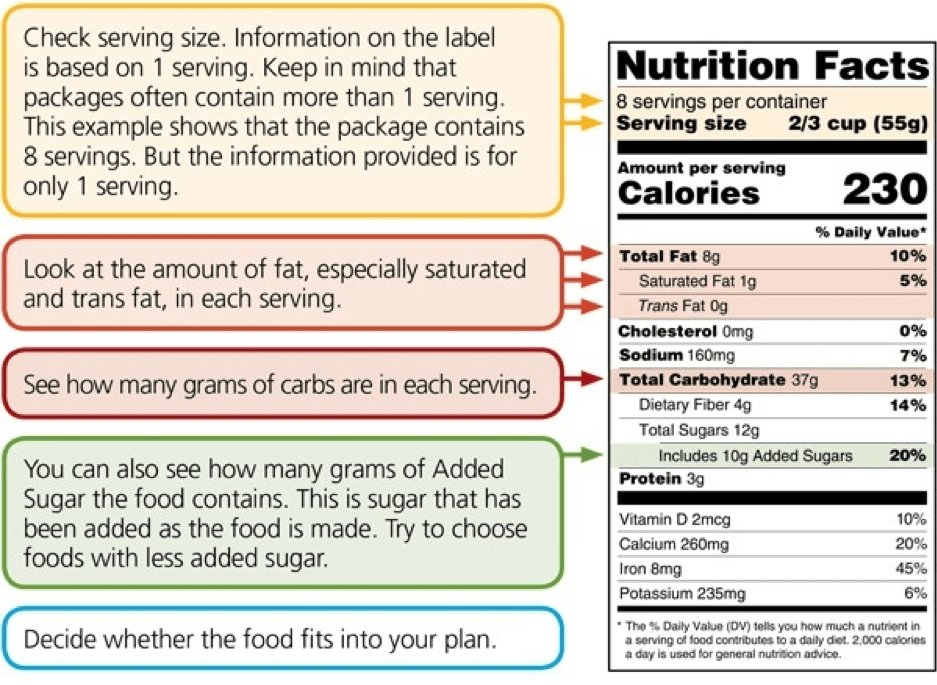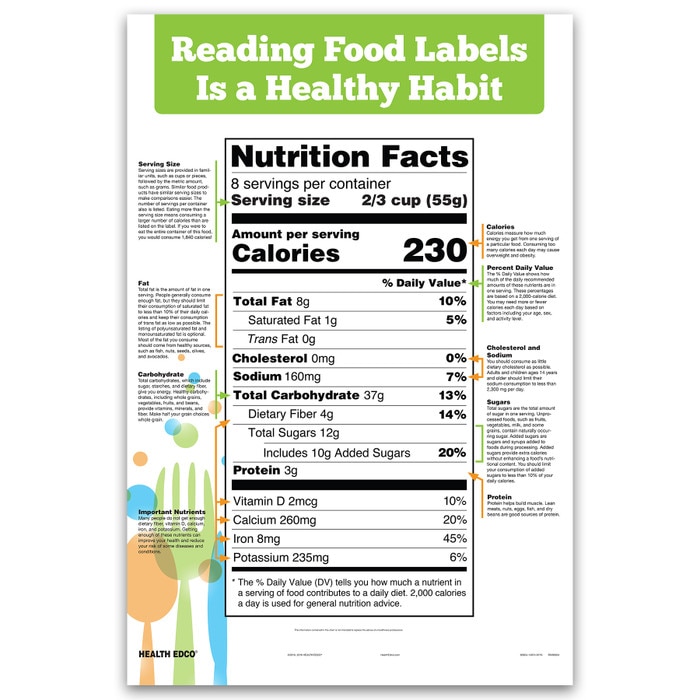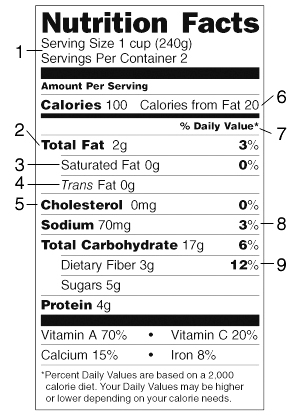41 reading fat on nutrition labels
› food › new-nutrition-facts-labelHow to Understand and Use the Nutrition Facts Label | FDA Nutrients to get less of: Saturated Fat, Sodium, and Added Sugars. Saturated fat, sodium, and added sugars are nutrients listed on the label that may be associated with adverse health effects - and... How to read food labels: MedlinePlus Medical Encyclopedia If a food has less than 0.5 grams of saturated fat in the serving size on the label, the food maker can say it contains no saturated fat. Remember this if you eat more than 1 serving. You should also pay attention to trans fats on any food label. These fats raise "bad" cholesterol and lower your "good" cholesterol.
› medialibraries › urmcmediaA Guide to Reading Food Labels - University of Rochester Feb 27, 2013 · of calories from fat. You should limit the number of calories from fat to 20-35% of your total daily calories. In the sample label, there are 250 calories in one serving and 110 calories from fat. This means almost 50% of the calories in a single serving of this food come from fat. Due to its high fat content, this food is not a healthy choice.

Reading fat on nutrition labels
Nutrition Facts: How to Read Nutrition Labels - Greatist The nutrition label lists total fat, saturated fat, and trans fat. It's the last two you want to focus on. Saturated fat is the kind you'll find in a burger, hot dog, or glass of whole milk. Eating... How to Read Nutrition Facts Label | Food Network Healthy Eats: Recipes ... If you're eating 1600 calories, that equals about 17 grams of saturated fat per day. If you want to go with the American Heart Association's recommendations, that number will be 8.8 grams for the... Reading Nutrition Facts Labels - University of Arizona As a guideline, a % daily value about 20% is high and below 5% is considered low. So this product is high is Calcium and Sodium, but low in Iron, Fiber and Vitamins A and C. Look out for saturated fat, trans fat, sodium and cholesterol. These are all linked to cardiovascular disease and should be limited in the diet.
Reading fat on nutrition labels. Weight Loss Surgery | Anne Arundel Medical Center - aahs.org Low-cholesterol foods have less than 20 mg of cholesterol and 2 grams or less of saturated fat per serving. "Reduced" foods have 25 percent less of specified nutrient or calories than the original product. Low-calorie foods have less than 5 calories per serving. Fat free or sugar-free foods have less than ½ gram of fat or sugar per serving. › reading-food-labelsReading Food Labels | ADA - American Diabetes Association The Nutrition Facts labels on foods are really the key to making the best choices. We'll cover the basics so that these labels make shopping easier for you. You've heard it all. From carb-free to low-carb, to whole and empty carbs, it's hard to know what it all means. Blood sugar highs and lows aren't always easy to understand. How to Read Nutrition Labels: Fat Content, Carbs & What To Look For Nutrition labels are required to include total fat, saturated fat, and trans fat. The total amount of fat in the diet is a percentage of your calorie needs. The recommendation for the typical American diet is around 30%. For someone taking in 2,000 calories, this would mean around 70 grams of total fat per day. How to read nutrition labels | safefood Nutrition information can be found on the back/side of food labels. Sometimes you will also find a snapshot of this information on the front of pack. Nutrition information is displayed per 100g and sometimes per recommended serving. Use the per 100g column to compare products. Look at the recommended portion size.
How to Read a Nutrition Label - ThinkHealth Nutrients you want to limit include saturated fat, sodium and added sugars. Eating too much saturated fat and sodium may increase the risk of developing cardiovascular disease and high blood pressure. Total sugars include those naturally present in many nutritious foods and beverages, such as milk and fruit. Nutrition: How to Read a Nutrition Facts Label - familydoctor.org This type of fat also increases your risk of heart disease. Ideally, you should get 0 grams of trans fat per day. Keep in mind, companies can list 0 grams if it contains less than 0.5 grams of trans fat per serving. This means that your food may have trans fats even if the nutrition label says 0. Check the ingredient list for trans fats products. How To Read Food and Beverage Labels - National Institute on Aging At the top of the Nutrition Facts label, you will find the total number of servings in the container and the food or beverage's serving size. The serving size on the label is based on the amount of food that people may typically eat at one time and is not a recommendation of how much to eat. Read more about serving and portion sizes. › managing › eat-wellFood Labels | CDC Apr 23, 2021 · If you eat the whole thing, you are eating 8 times the amount of calories, carbs, fat, etc., shown on the label. Total Carbohydrate shows you types of carbs in the food, including sugar and fiber. Choose foods with more fiber, vitamins, and minerals. Choose foods with lower calories, saturated fat, sodium, and added sugars. Avoid trans fat.
PDF Food and Nutrition Reading Nutrition Labels - University of Washington Listing trans fats on nutrition labels became a requirement in the U.S. in 2006. If a product contains less than 0.5 grams trans fat per serving, the label can say 0 grams trans fat. But, if you have more than 1 serving of the product, you may be eating an amount of trans fat that can affect your health. How To Read Nutrition Labels: Fat Content, Carbs & What To Look For ... Read on for a comprehensive guide on how to read nutrition labels. Anatomy of Nutrition Labels Serving Information. Serving information is often the first thing you will see on a label. It indicates how many servings are in the package and what the average serving size is. These are often standardized in cups or pieces or a metric amount in grams. 3 Ways to Read Nutrition Facts on Food Labels - wikiHow Every number listed beneath "total fat" is calculated based on the amount contained in a single serving. So if the saturated fat on a label is listed at 6 grams but the number of servings is listed as 3, it means that there are a total of 18 grams of saturated fat in the container. [1] How To Read Nutrition Labels Like a Dietitian [Infographic] Nutrition labels are great; they help you figure out the ingredients and nutritional composition of a food product. Sometimes, though, they can be a bit deceitful. That snack may look healthy with only 6% of your daily saturated fat intake and 5% of your sodium, but take a closer look, and you realize that serving size is four crackers.
kidshealth.org › en › teensFood Labels (for Teens) - Nemours KidsHealth The information on food labels is based on an average adult diet of 2,000 calories per day. The actual number of calories and nutrients that kids need will depend on their age, weight, gender, and level of physical activity. (For more guidance, check out the USDA's MyPlate.) Fat. Total fat shows how much fat is in a single serving of food.
How to Read Nutrition Facts Labels the Right Way - GoodRx Healthy fats can be a bit harder to find on a nutrition label. They are not required to be listed under "total fat," although some food manufacturers may voluntarily do so. Even if a product does not list these fats, you can identify them by becoming familiar with the sources of each type of fat. Sources of monounsaturated fats include: Nuts Seeds
Get the Facts! Steps to Reading and Understanding Nutrition Facts Labels Food labels list percentages of the recommended daily intakes of several nutrients. The numbers are based on a 2,000-calorie diet and are used for adults who are 18 years or older. If you consume more or less than 2,000 calories per day, you still can use % Daily Values as a reference.
How to Read a Nutrition Label - Arthritis Foundation Look for products with less than 1g of saturated fat and no trans fat, says registered dietitian Jennifer Vimbor of Nutrition Counseling Services in New York. And if you're looking to lose weight, look for foods that are low in fat overall, she says. Foods with the "low fat" label, for example, contain fewer than 3 grams of fat per serving.
Reading Nutrition Facts Labels - EFNEP - Expanded Food and Nutrition ... Percent Daily Values (%DV) tell you how much of a certain nutrient you will get from the product. If the label says "10% Total Fat," this means one serving of the food is 10% of all the fat you should be eating each day. However, Daily Values (DV) are based on a 2,000 calorie per day diet. You may need more or less than 2,000 calories per day.

Reading Nutrition Labels: Vitamins and Minerals | Nutrition facts label, Nutrition facts ...
How to Read Nutrition Labels - Roswell Park Comprehensive Cancer Center According to the AICR, it's recommended that less than 30 percent of your daily calories come from fat. In the sample nutrition label above, 110 out of 250 total calories means 44% of this food's calories come from fat. Keep in mind this could be balanced out with lower calorie-from-fat foods throughout the day. 3. Limit These Nutrients (Yellow)
How to Read a Nutrition Label - WebMD Here's a label-reading shortcut. First, ignore the "sell" on the front. Go straight to the back and look at %DV. According to the FDA, you should look for nutrients you want, such as fiber, to ...

nutrition labels percentages - Google Search | Nutrition facts label, Nutrition labels ...
How to Use the Nutrition Fact Label, Eat Right, NHLBI, NIH Get enough of these: potassium, fiber, vitamins A and C, calcium, and iron Use the Percent Daily Value (% DV) column when possible; 5% DV or less is low, 20% DV or more is high Visit the Smart Food Shopping page and learn how the label can help you choose foods lower in calories, fat, and added sugar to help maintain a healthy weight.
Food Labels: Fat & Cholesterol | Home & Garden Information Center The Nutrition Facts label shows you how much fat is in a product, even if the fat is hidden as an ingredient. The serving size and the nutrients listed on this label are consistent, which makes it easy to compare similar products without any calculations. % Daily Values (% DVs) are listed in a column on the "Nutrition Facts" label.
Fat Content on Food Labels - Reading Between the Lines The Mayo Foundation continued, "Still, you may be able to tell if a product contains trans fat, even if it's not directly listed on the food label. Look for the words ' hydrogenated ' or 'partially hydrogenated' in the list of ingredients. These terms indicate that the product contains trans fat.
› media › 131162Quick Tips for Reading the Nutrition Facts Label To create your Tip Card: 1. Use a pair of scissors to cut along the dotted lines. 2. Fold along the center line. 3. Keep the Tip Card in your wallet or purse. Calories230 Amount per serving Serving...
Understanding Food Nutrition Labels | American Heart Association When the Nutrition Facts label says a food contains "0 g" of trans fat, but includes "partially hydrogenated oil" in the ingredient list, it means the food contains some trans fat, but less than 0.5 grams per serving. So, if you eat more than one serving, you could end up eating too much trans fat.
› food › nutritionThe Basics of the Nutrition Facts Label - Eatright.org Mar 04, 2022 · Low is 5% or less. Aim low in saturated fat, trans fat, cholesterol and sodium. High is 20% or more. Aim high in vitamins, minerals and dietary fiber. Step 4: Check Out the Nutrition Terms. Low calorie: 40 calories or less per serving. Low cholesterol: 20 milligrams or less and 2 grams or less of saturated fat per serving.
How to Read Nutrition Labels - frederickhealth.org Limit saturated fat, trans fat, sodium, and added sugars. They only increase your risk of heart disease, high blood pressure, cancer, and more. Instead, eat more dietary fiber, vitamin D, calcium, iron, potassium, protein, and select carbohydrates like whole-grain breads, rice, and vegetables.
Reading Nutrition Facts Labels - University of Arizona As a guideline, a % daily value about 20% is high and below 5% is considered low. So this product is high is Calcium and Sodium, but low in Iron, Fiber and Vitamins A and C. Look out for saturated fat, trans fat, sodium and cholesterol. These are all linked to cardiovascular disease and should be limited in the diet.
How to Read Nutrition Facts Label | Food Network Healthy Eats: Recipes ... If you're eating 1600 calories, that equals about 17 grams of saturated fat per day. If you want to go with the American Heart Association's recommendations, that number will be 8.8 grams for the...
Nutrition Facts: How to Read Nutrition Labels - Greatist The nutrition label lists total fat, saturated fat, and trans fat. It's the last two you want to focus on. Saturated fat is the kind you'll find in a burger, hot dog, or glass of whole milk. Eating...









Post a Comment for "41 reading fat on nutrition labels"